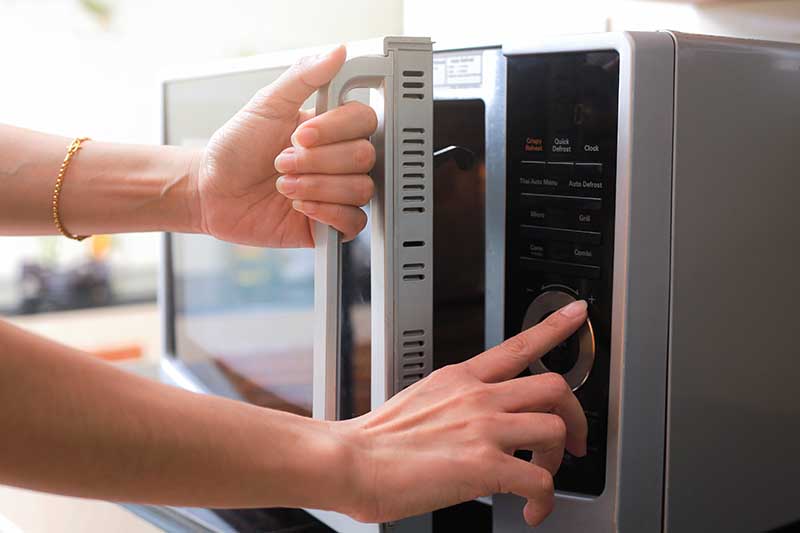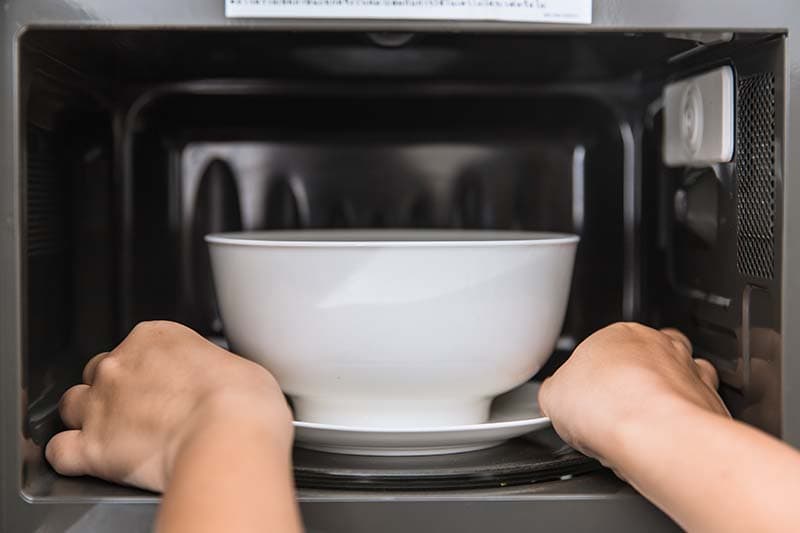Is Ceramic Microwave Safe? (Microwave Safety Tips)
-
- Last updated:

Ceramic is an ancient material that is commonly found in a variety of kitchen items, including serving trays, bowls, plates, and cups. The prevalence of ceramic makes people think that it is entirely microwave safe. But is that true? Is ceramic microwave safe? What is ceramic made of?
The answer is that, in most cases, modern ceramic is completely microwave safe and is designed with the modern kitchen in mind. However, since ceramics are so old and so varied, there are some items that might not be suitable for the microwave. Here is what you should look out for and how to tell if your ceramic dishes are safe to go into your microwave.

What Is Ceramic?
Ceramic is a type of material made from inorganic elements that is fired at high heat. Ceramic is most commonly made from clay and is shaped and then fired in a kiln at high heat. Modern ceramic is then usually glazed for shine and protection. Unglazed ceramic is often called earthenware. Ceramic has been around for centuries, if not millennia, and is one of humanity’s oldest and most reliable products. Ceramics are naturally heat resistant which is why they make for good microwavable material.
Modern cups and dishes are commonly made from ceramic material, but that only represents a small portion of ceramic’s potential. Ceramic is also used in modern toilets, bricks, and tiles.

Can You Microwave Ceramic?
Ceramic can generally withstand the conditions found in a typical microwave. Almost all modern ceramic dishes and cups are designed to be able to be microwaved. However, not all ceramics should be microwaved, and there are some things you should be aware of before putting your ceramic dish into the box.
You should always check your ceramic dishes for a stamp that denotes whether it is microwave safe or not. Modern ceramic dishes should all have a label that says microwave safe or not microwave safe. This is where everyone should start before microwaving any ceramics. Obviously, ceramic that is marked unsafe for microwaves should not be put into the microwave under any circumstances.
There are some other safety concerns that you should be aware of for the best results including the age of the dish, any inlays or decorative pieces, and the temperature of the dish.

Do Not Microwave Cold Ceramic
Many people like to store things in the refrigerator or freezer on ceramic plates. Leftovers, chilled desserts, and food platters are commonly found stored on ceramic. Some people have the urge to take a choice portion of leftovers directly out of the refrigerator and pop it right into the microwave for a quick meal, but that is inadvisable. Heating cold ceramic can lead to uneven heating, cracks, or even shattering. You should always let the ceramic warm to room temperature before putting it into the microwave whenever possible.
Watch for Decorative Elements
Some ceramic includes decorative elements that might not be microwave safe. Some things to look out for include any type of inlay and metallic rims. Inlays could be made from metals like silver or gold, which are not microwave safe. Similarly, any ceramic with a metallic rim, edge, or border should not be put into the microwave. Some earthenware cups have metal rings to make drinking smoother, but they then cannot be microwaved.
Check Old Ceramic Before Microwaving
Ceramics have been around for centuries, and some ceramic dishes can be extremely old. Many people might even inherit antique ceramics from a family member without even realizing it. The problem is that old ceramic was not made in the same way as modern ceramics. There were fewer regulations and less uniformity in the ceramic market. Antique ceramic could have been made in a factory or a shed on a craftsman’s property. That means that old ceramic items might not adhere to the same microwavable standards as more modern examples. Remember that the microwave was not invented until the 1970s, so ceramic created prior to 1970 was not fired with microwaves in mind.
Check your older ceramic dishes for markings. Look for microwave safe labels. The bottom of the dish will say microwave safe and have a picture of a microwave or a symbol with three wavy lines. If these markings are present, the dish is safe. If there are no markings, you should be careful about microwaving it.
Antique ceramics also use different glazes than modern ceramics. Some old glaze contained harmful elements such as lead which are not safe to be microwaved today. The safest bet is if you do not know how old your ceramic is or if it is unmarked, you should refrain from microwaving it.

Do Not Microwave Damaged Ceramic
Ceramic is stronger than glass, but it is not impervious to damage. Ceramics can easily become chipped or cracked, especially over time. You should never microwave damaged ceramic because it can lead to severe issues. One of the biggest risks of microwaving damaged ceramic is causing further damage. Ceramic that is already cracked is at a higher risk of cracking further, splitting, or even shattering.
Another issue that can arise if you microwave damaged ceramic is uneven heating. Sometimes exposed edges or chips can heat faster than the glazed and undamaged portions. That can lead to surprisingly hot spots that can cause burns when handled. The safest bet is to simply retire damaged ceramics from microwave use or retire them completely.
Dangers of Improperly Microwaving Ceramic
There are two primary dangers of improperly microwaving ceramic. If you put ceramic in the microwave that is not microwave safe, it will either heat up to unsafe levels, or it will crack. If you reach into the microwave to grab a ceramic dish or cup and you immediately burn your fingers, the ceramic is likely not microwave safe. Excessively hot ceramic is very dangerous. It can burn you and lead people to drop their dishes in surprise, which can send hot food flying.
The other common issue with ceramic that is not microwave safe is the risk of cracking and splitting. If you heat ceramic, especially old or low-fired ceramic, you can crack the surface. Once ceramic is cracked it is at a higher risk of failure. If you microwave cracked ceramic, it can lead to the dish shattering, which can cause a mess and lead to sharp shards. Cleaning up shards of ceramic from a microwave can pose a cutting risk.


Conclusion
Ceramic is a prevalent material that is commonly thrown into the microwave without a second thought. In most cases, that is completely safe, but not always. Microwaving ceramic that is not microwave safe can lead to excessive heat buildup and cracking. Some ceramic with inlays or toxic glaze can cause hazards to your food and your microwave. It is always prudent to examine any new ceramic items for microwave safe labels just to be safe.
See also:
Featured Image Credit: Zyn Chakrapong, Shutterstock
Contents

